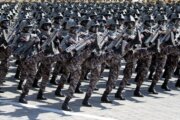WASHINGTON — Just how much of an impact does wearing a body camera have on a police officer’s behavior? It turns out, not much.
A new study, sponsored by the city’s The Lab @ DC, and conducted by scientists reviewed police interactions of over a thousand officers who wore cameras, and over a thousand officers who did not.
They compared the number of citations for disorderly conduct those officers administered, the number of complaints made about those officers, and the number of times they used force with someone.
The results showed that the idea that wearing a body camera does not influence how an officer acts, at least in terms of this study. There wasn’t much difference.
When it came to disorderly conduct arrests, there were slightly more made by officers who were not wearing the cameras, though the report says the difference between the two was marginal. Likewise, those who were wearing cameras documented slightly more incidents where force was used, but the difference in that case was even more marginal.
The number of complaints filed against officers wearing body cameras was actually slightly higher than the number made against officers without the cameras. But, as was the case with the other two measured incidents, scientists say it would be a stretch to conclude the cameras had much of an impact in that regard.
It’s worth noting that the use of body-worn cameras among officers is much more prevalent now than it was when this study began, and city leaders caution that the results of the study don’t mean the cameras are an expensive waste of taxpayer dollars.
D.C. police Chief Peter Newsham told The New York Times that, while he was surprised by the study, he also thinks some of the benefits are tougher to measure. City leaders in the mayor’s office, on the council, and high up in the department, as well as leaders in the police union, have all said that the cameras provide a level of transparency not previously attainable, with the union arguing the cameras would show that incidents of police abuse tended to be overblown, if not fabricated.
When the city first started using them, union leaders welcomed the extra level of transparency.
Newsham told The New York Times that “you can’t underestimate the value these cameras bring” to legitimacy and trust in the community. That’s a thought echoed by Michael Tobin, who leads the Office of Police Complaints. Tobin told NBC Washington that “just having the cameras there, and having an outside, third-party witness at every interaction improves community trust.”
According to The New York Times, the impact of body-worn cameras in D.C. may have been less because its police department has already had to confront excessive-force problems.
In 1998, The Washington Post wrote a series of articles detailing the deadly force used by police in the city. After the article series was published, the Department of Justice entered into an agreement with D.C. to reform its policing, The New York Times reported.
This new study differs from the results of a 2012 study in Rialto, California, where researchers found that the likelihood of force being used when body-worn cameras were not worn was twice those when officers had them on.
The Rialto study also found that complaints filed against officers dropped from 0.7 complaints per 1,000 contacts to 0.07 per 1,000.
The Rialto study featured 54 officers. The Lab @ DC study consisted of 2,224 D.C. officers.








